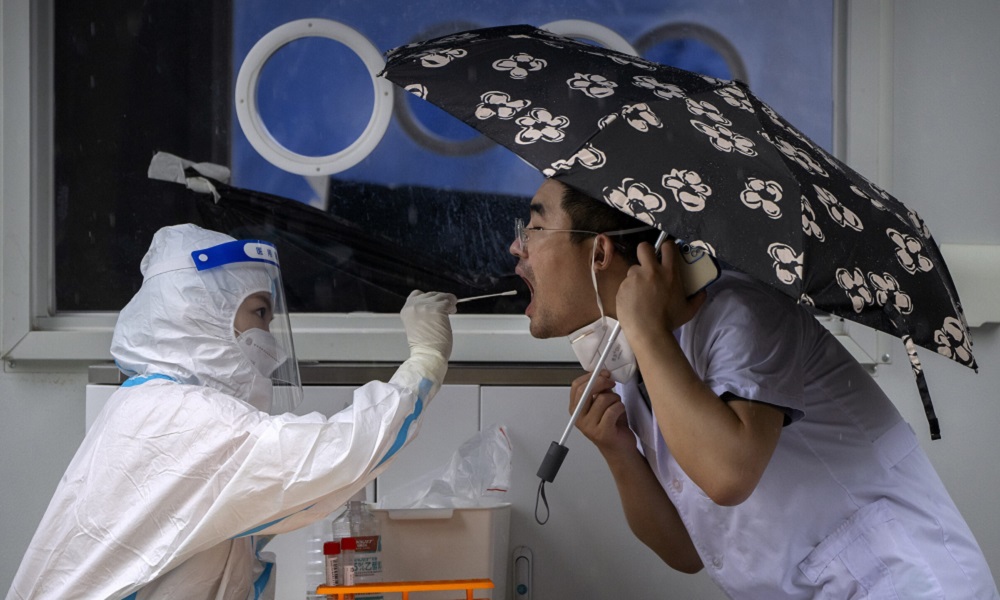COVID-19
Beijing curbs public transport as COVID spreads in China

The Chinese capital Beijing shut dozens of metro stations and bus routes on Wednesday in its campaign to stop the spread of COVID-19 and avoid the fate of Shanghai where millions of residents have been under strict lockdown for more than a month.
New evidence has emerged that China's uncompromising battle against the coronavirus, believed to have emerged in a market in the city of Wuhan in late 2019, is undermining its growth and hurting the international companies invested there.
Late on Tuesday, another city announced work-from-home and other COVID curbs for the coming week. The central city of Zhengzhou, home to 12.6 million people and a factory of Apple's iPhone manufacturer Foxconn (2354.TW), joins dozens of big cities in full or partial lockdown.
The capital shut more than 40 subway stations, about a tenth of the network, and 158 bus routes, service providers said. Most of the suspended stations and routes are in the Chaoyang district, the epicentre of Beijing's outbreak.
With dozens of new cases a day, Beijing is trying to avoid a full lockdown, as Shanghai also did initially, instead hoping that mass testing will find and isolate the virus before it can spread.
The city of 22 million people has closed schools as well as some businesses and residential buildings in high-risk areas, and many people are stocking up in case a full lockdown does come.
Twelve out of 16 Beijing districts were conducting the second of three rounds of tests this week, having done three mass screenings last week.
In Shanghai, there's no end in sight for the lockdown.
After more than a month, most people in mainland China's biggest city and its financial centre are still not allowed to leave their housing compounds.
Some of Shanghai's 25 million people have benefited from a tentative easing of precautions since Sunday, with usually just one member of a household allowed out for a quick stroll, some fresh air and a bit of shopping at supermarkets.
According to the latest data, Shanghai found 63 new cases outside areas under the strictest curbs, suggesting the city has a way to go to reach the goal of no cases for several days before curbs can ease significantly.
Authorities say the zero-COVID policy aims to save as many lives as possible, pointing to the millions of COVID deaths outside China, where many countries are throwing off precautions to "live with COVID" even as infections spread.
But the policy is hurting domestic consumption and factory output, disrupting key global supply chains and shrinking revenues for some of the biggest international brands, such as Apple (AAPL.O), Gucci-parent Kering (PRTP.PA) and Taco Bell-owner Yum China (9987.HK).
Capital Economics estimates COVID has spread to areas generating 40% of China's output and 80% of its exports - all facing various degrees of restrictions.
"Recent mobility trends suggest that China’s growth momentum deteriorated significantly in April, with traffic congestion, subway passenger volume and other high-frequency indicators at their weakest since the initial outbreak," Fitch Ratings said in a note.
Its analysts cut their 2022 growth forecast to 4.3%, from 4.8%, well below China's official 5.5% target.
Starbucks Corp (SBUX.O) suspended its guidance for the rest of its fiscal year on Tuesday mainly due to China's COVID curbs. Sales in China, where the chain has rapidly expanded in recent years, declined 23%, overshadowing 12% growth in North America.
Foxconn said on Wednesday it was continuing production in Zhengzhou.
Numerous factories were shut after Shanghai went into lockdown from March. While some have started reopening, getting workers back, while dealing with snarled supply chains, has proven difficult.
Shanghai authorities helped Tesla (TSLA.O) transport over 6,000 workers and carry out disinfection work to reopen its factory last month, according to a letter that Tesla sent to officials and seen by Reuters.
International trade is also facing disruption.
A study by Royal Bank of Canada analysts found that a fifth of the global container ship fleet was stuck in congestion at various major ports. read more
At Shanghai's port, 344 ships were awaiting berth, a 34% increase over the past month. Shipping something from a warehouse in China to one in the United States takes 74 days longer than usual, they said.
COVID-19
WHO declares end to COVID global health emergency

The World Health Organization said Friday that COVID-19 no longer qualifies as a global emergency, marking a symbolic end to the devastating coronavirus pandemic that triggered once-unthinkable lockdowns, upended economies and killed millions of people worldwide.
The announcement, made more than three years after WHO declared the coronavirus an international crisis, offers some relief, if not an ending, to a pandemic that stirred fear and suspicion, hand-wringing and finger-pointing across the globe, AP reported.
The U.N. health agency’s officials said that even though the emergency phase was over, the pandemic hasn’t finished, noting recent spikes in cases in Southeast Asia and the Middle East.
WHO says thousands of people are still dying from the virus every week, and millions of others are suffering from debilitating, long-term effects.
“It’s with great hope that I declare COVID-19 over as a global health emergency,” WHO Director-General Tedros Adhanom Ghebreyesus said.
“That does not mean COVID-19 is over as a global health threat,” he said, warning that new variants could yet emerge. Tedros noted that while the official COVID-19 death toll was 7 million, the real figure was estimated to be at least 20 million.
Tedros said the pandemic had been on a downward trend for more than a year, acknowledging that most countries have already returned to life before COVID-19.
He bemoaned the damage that COVID-19 had done to the global community, saying the pandemic had shattered businesses, exacerbated political divisions, led to the spread of misinformation and plunged millions into poverty.
When the U.N. health agency first declared the coronavirus to be an international crisis on Jan. 30, 2020, it hadn’t yet been named COVID-19 and there were no major outbreaks beyond China.
More than three years later, the virus has caused an estimated 764 million cases globally and about 5 billion people have received at least one dose of vaccine.
In the U.S., the public health emergency declaration made regarding COVID-19 is set to expire on May 11, when wide-ranging measures to support the pandemic response, including vaccine mandates, will end. Many other countries, including Germany, France and Britain, dropped most of their provisions against the pandemic last year.
When Tedros declared COVID-19 to be an emergency in 2020, he said his greatest fear was the virus’ potential to spread in countries with weak health systems.
Most recently, WHO has struggled to investigate the origins of the coronavirus, a challenging scientific endeavor that has also become politically fraught.
COVID-19
COVID-19 in Iran: Nearly 900 new cases, 24 deaths recorded

The Iranian health ministry announced on Sunday that more than 890 new cases of COVID-19 have been identified across the country during the past 24 hours, adding that 24 patients have died in the same period of time, Fars News Agency reported.
"A sum of 891 new patients infected with COVID-19 have been identified in the country based on confirmed diagnosis criteria during the past 24 hours," the Iranian Health Ministry's Public Relations Center said on Sunday, adding, "454 patients have been hospitalized during the same time span."
The ministry’s public relations center said 611 people infected with COVID-19 are in critical condition.
COVID-19
China says 200 million treated, pandemic ‘decisively’ beaten

China says more than 200 million of its citizens have been diagnosed and treated for COVID-19 since it lifted strict containment measures beginning in November.
With 800,000 of the most critically ill patients having recovered, China has “decisively beaten” the pandemic, according to notes from a meeting of the ruling Communist Party’s all-powerful Politburo Standing Committee presided over by President and party leader Xi Jinping, AP reported.
China enforced some of the world’s most draconian lockdowns, quarantines and travel restrictions and still faces questions about the origins of the virus that was first detected in the central Chinese city of Wuhan in late 2019. Heavy-handed enforcement prompted rare anti-government protests and took a heavy toll on the world’s second-largest economy.
The official Xinhua News Agency quoted Xi as saying that policies to control the outbreak had been “entirely correct.” The abrupt lifting in November and December of the “zero COVID” policy that had sought to eliminate all cases of the virus led to a surge in infections that temporarily overwhelmed hospitals.
Case numbers have since peaked and life has largely returned to normal, although international travel in and out of China has yet to return to pre-pandemic levels.
China is now transitioning to a post-pandemic stage after a fight against the outbreak that was “extraordinary in the extreme,” Xinhua said.
The government will continue to “optimize and adjust prevention and control policies and measures according to the times and situations with a strong historical responsibility and strong strategic determination,” Xinhua said.
-

 Latest News5 days ago
Latest News5 days agoIndia hoping to import coal and marble from Afghanistan
-

 Sport4 days ago
Sport4 days agoZimbabwe’s opening ODI against Afghanistan abandoned
-

 Latest News5 days ago
Latest News5 days agoJapan announces $27.5 million aid package to Afghanistan
-

 Latest News1 day ago
Latest News1 day agoAfghan men must stand with women to support viable future of country: US envoy
-

 World3 days ago
World3 days agoNorth Korean troops suffer 100 deaths, struggling in drone warfare, South Korea says
-

 Latest News3 days ago
Latest News3 days agoTwo horror accidents on Kabul-Kandahar highway leave 52 dead
-

 International Sports4 days ago
International Sports4 days agoLanka T10: Kandy Bolts in at 4th spot in playoffs after thrilling day
-

 Sport3 days ago
Sport3 days agoAfghanistan crush Zimbabwe by 232 runs in second ODI
























